Understanding Bioanalytical Chemistry: Principles and ApplicationsISBN: 978-0-470-02907-7
Paperback
304 pages
March 2009
 This is a Print-on-Demand title. It will be printed specifically to fill your order. Please allow an additional 10-15 days delivery time. The book is not returnable.
Other Available Formats: Hardcover
|
||||||
Preface ix
1 Introduction to biomolecules 1
1.1 Overview of chemical and physical attributes of biomolecules 2
1.2 Classification of biomolecules 5
1.3 Features and characteristics of major biomolecules 6
1.4 Structure–function relationships 21
1.5 Significance of biomolecules in nature and science 21
2 Analysis and quantification of biomolecules 29
2.1 Importance of accurate determination of biomolecules 30
2.2 Major methods to detect and quantify biomolecules 33
2.3 Understanding mass, weight, volume and density 34
2.4 Understanding moles and molarity 38
2.5 Understanding solubility and dilutions 46
3 Transition metals in health and disease 53
3.1 Structure and characteristics of key transition metals 54
3.2 Importance of transition metals in physiological processes 60
3.3 Transition metals as mediators of disease processes 64
3.4 Therapeutic implications of transition metals 71
3.5 Determination of transition metals in nature 73
4 Ions, electrodes and biosensors 77
4.1 Impact of ions and oxidation–reduction reactions on physical and life processes 78
4.2 pH, biochemical buffers and physiological regulation 83
4.3 Chemical and physical sensors and biosensors 88
4.4 Important measurements using specific electrodes 91
4.5 Specific applications of biosensors in life and health sciences 93
5 Applications of spectroscopy 99
5.1 An introduction to spectroscopic techniques 100
5.2 Major types of spectroscopy 104
5.3 Principles and applications of ultraviolet/visible spectrophotometry 105
5.4 Principles and applications of infrared spectroscopy 113
5.5 Principles and applications of fluorescence spectrofluorimetry 118
6 Centrifugation and separation 123
6.1 Importance of separation methods to isolate biomolecules 124
6.2 Basic principles underlying centrifugation 126
6.3 Features and components of major types of centrifuge 129
6.4 Major centrifugation methods for bioanalysis 133
6.5 Flow cytometry: principles and applications of this core method of separation 136
7 Chromatography of biomolecules 141
7.1 Chromatography: a key method for separation and identification of biomolecules 142
7.2 Principles, types and modes of chromatography 143
7.3 Applications of chromatography in life and health sciences 153
7.4 High-performance liquid chromatography and advanced separation technologies 154
7.5 Additional state-of-the-art chromatography techniques 160
8 Principles and applications of electrophoresis 163
8.1 Principles and theory of electrophoretic separation 164
8.2 Major types of electrophoresis 165
8.3 Electrophoresis in practice 169
8.4 Applications of electrophoresis in life and health sciences 177
8.5 Advanced electrophoretic separation methodologies for genomics and proteomics 178
9 Applications of mass spectrometry 183
9.1 Major types of mass spectrometry 184
9.2 Understanding the core principles of mass spectrometry 186
9.3 Major types of mass spectrometry in practice 191
9.4 Mass spectrometry: a key tool for bioanalysis in life and health sciences 194
9.5 Mass spectrometry: future perspectives 196
10 Immunochemical techniques and biological tracers 199
10.1 Antibodies: the keys to immunochemical measurements 200
10.2 Analytical applications of biological tracers 208
10.3 Principles and applications of radioimmunoassay (RIA) 212
10.4 Principles and applications of enzyme-linked immunosorbent assay (ELISA) 216
10.5 Immunohistochemistry: an important diagnostic tool 221
11 Bioanalysis by magnetic resonance technologies: NMR and MRI 225
11.1 Nuclear magnetic resonance (NMR) and magnetic resonance imaging (MRI) technologies: key tools for the life and health sciences 226
11.2 Principles of NMR and the importance of this biomolecular analytical technique 229
11.3 Established and emerging applications of NMR 235
11.4 Principles and uses of MRI 236
11.5 MRI as a principal diagnostic and research tool 241
12 Bioanalytical approaches from diagnostic, research and pharmaceutical perspectives 247
12.1 Clinical genomics, proteomics and metabolomics 248
12.2 Clinical diagnosis and screening 251
12.3 Research and development 254
12.4 Emerging pharmaceutical products 258
12.5 Future perspectives 260
13 Self-Assessment 265
Appendix 1: International system of units (SI) and common prefixes 273
Appendix 2: The periodic table of the elements 275
Appendix 3: Common solvents and biological buffers 277
Appendix 4: Answers to self-assessment questions 279
Index 281



